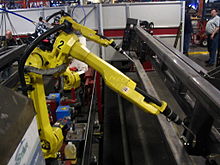 Metal fabrication is a key segment of the country’s manufacturing industry. As explained by the Bureau of Labor Statistics (BLS), it involves a wide range of processes, including the smelting and/or refinement of metals, as well manufacturing metal alloys and superalloys. These metals are then used to make castings and other metal products. There are many techniques used in metal fabrication, however, some of which we’re going to explore.
Metal fabrication is a key segment of the country’s manufacturing industry. As explained by the Bureau of Labor Statistics (BLS), it involves a wide range of processes, including the smelting and/or refinement of metals, as well manufacturing metal alloys and superalloys. These metals are then used to make castings and other metal products. There are many techniques used in metal fabrication, however, some of which we’re going to explore.
Cutting
Metal fabrication companies cut metal through the use of specialized tools, including oxy-fuel and plasma torches. With the ability for some models to achieve temperatures of 45,000 degrees, plasma torch is particularly effective for cutting metal. Some people assume that plasma torches are hazardous for this reason, but this isn’t necessarily the case. The “arc” that reaches these extreme temperatures is very small, so the chance of accidentally touching it against your body is also small.
Other methods for cutting metal include sawing, shearing, chiseling, and numerical control cutters like lasers, mill bits and water jets.
Bending
To bend metal, fabrication companies often use manual or powered hammers with press brakes and other related tools. The press brakes are used to coin or air-bend metal sheets into the desired shape and form. It offers a cleaner and more accurate bend. The metal is placed and secured on a flat surface, after which it is lifted to bend the metal at the appropriate angle. Metal brakes can achieve bends of up to 90 degrees, making them invaluable in fabrication.
Assembling
Assembling metal is achieved in several ways, with the most common being welding. Other options for assembling metal include binding with adhesives, using threaded fasteners, riveting, and bending in the form of a crimped seam.
Shrinking
It’s not uncommon for fabrication companies to shrink metal. Generally speaking, there are three main ways in which these companies shrink metal, the first of which is tucking. Arguably the oldest method, tucking involves forcing the metal between a crack with a hammer, or by folding the metal over its edges with a tucking fork. Tucking has been used by automakers to produce some of the earliest-model sports cars.
A second method for shrinking metal involve the use of a lever-operated tool known as a shrinker. This tool has jaws that grab the metal from both sides, squeezing it together. It’s more accurate than tucking, but it’s also more time-consuming.
The third method for shrinking metal is heat shrinking. Basically, it involves heating a stretched sheet of metal with a torch and then waiting for it to cool off. As the metal cools, it will naturally contract; thus, allowing for a smaller size.
